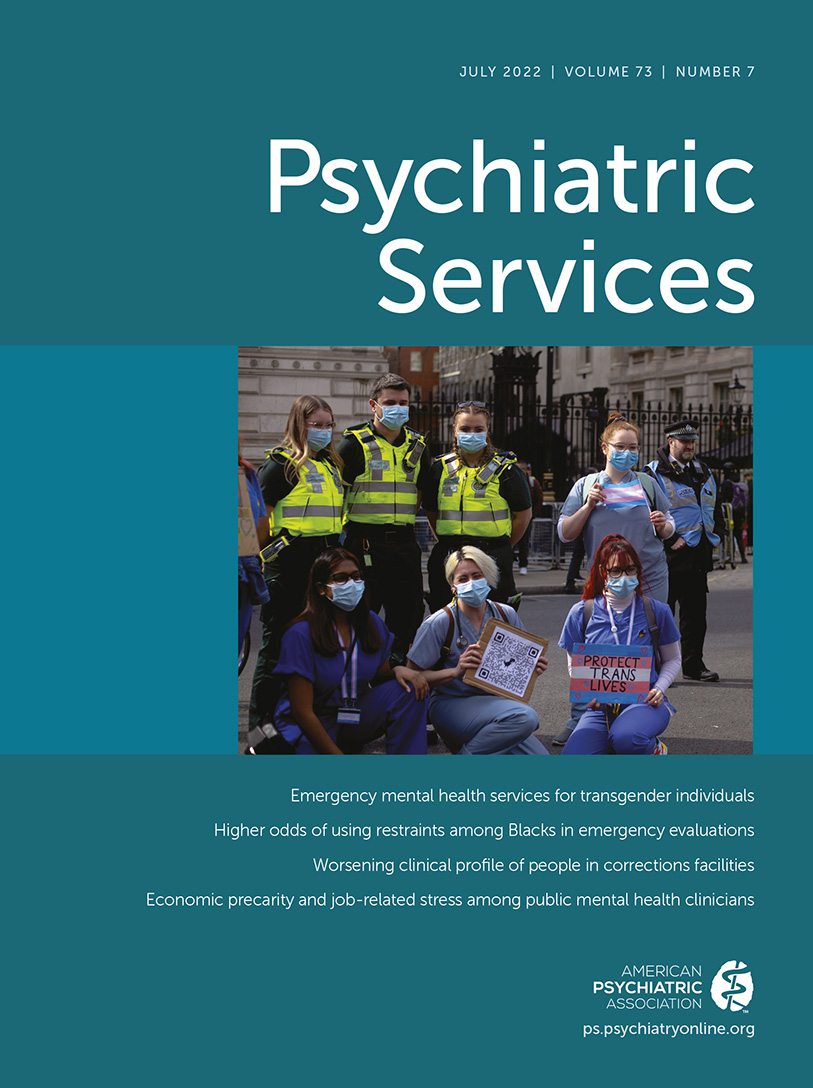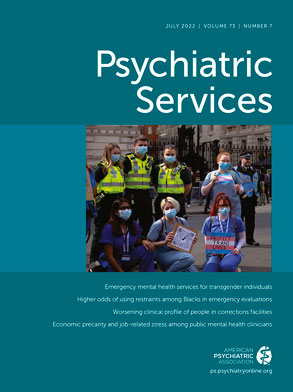The mental health needs of most children and families go unmet, particularly among racially and ethnically minoritized, low-income, and rural populations, who are also most likely to end treatment early (
1–
6). To promote overall health, interventions are needed that foster engagement in mental health services among families that have been underserved because of barriers such as stigma, practical challenges (e.g., transportation or child care), and competing priorities (
7–
9). Peer-delivered family support services have emerged as a promising strategy to increase engagement in youth mental health services (
10,
11) because of their focus on educating and empowering caregivers to “take an active role in their child’s care” (
12), which may have an impact on both attitudes and behaviors related to service engagement (
13). In youth mental health, peer providers are “veteran parents” with experience negotiating complicated service systems for their own children (
14). These providers are referred to below as “peer parents.” Use of family support services delivered by peer parents might increase service engagement among underserved groups, but rigorous trials of such services in youth mental health are lacking (
15–
17).
One example of an understudied peer parent–led family support service is NAMI Basics, developed by the National Alliance on Mental Illness (NAMI), the largest U.S. grassroots mental health organization and a major provider of peer-parent services. NAMI Basics is a six-class curriculum for caregivers of children under age 22 with mental health concerns, broadly defined. It is led by trained peer parents who volunteer with local NAMI affiliates and is provided free to caregivers in nonstigmatizing community settings (e.g., local school, church, or community center) in 43 states. NAMI Basics is focused on increasing parent knowledge about mental illness, empowering parents to advocate for their children across service systems, and introducing skills that assist in family problem solving and communication (
18). It is thus aligned with other peer-parent programs, which broadly target instructional support (e.g., skill building) and informational support (e.g., education about child development and child behavior) (
17). Parent activation—or the ability to communicate effectively with health providers about mental health care, ask about and discuss treatment options, take a proactive role in treatment and health, and understand how to avoid “emotional triggers” (
19)—has also been proposed as a potential target of these services (
17).
Research on NAMI Basics is encouraging. An initial pilot trial demonstrated increases in knowledge about youth mental illness and activation in a sample of 85 caregivers. A second study of 36 caregivers replicated and extended these results, demonstrating increases in family empowerment and caregiver self-care and reductions in inflammatory family communication (
18). However, these studies lacked control groups; this is consistent with most peer-parent support studies, which have relied on less rigorous pre-post or quasi-experimental designs (
17). A handful of randomized controlled trials (RCTs) have tested the clinical benefit of peer-parent services compared with standard care and found increases in caregiver knowledge and decreases in parenting stress (
20), decreases in parent anxiety (
21), and increases in caregiver service engagement (
22). Less commonly, RCTs have measured and found direct child benefits when caregivers participated in peer-parent interventions (
22,
23).
With the study reported here, we sought to add to the existing research on NAMI Basics specifically and peer-parent support services more broadly by testing the NAMI Basics curriculum in a randomized controlled effectiveness trial. Caregivers referred to NAMI Basics were randomly assigned to NAMI Basics or an 8-week waitlist control group. On the basis of prior NAMI Basics research and the intervention targets, we hypothesized that participants in NAMI Basics would show improvements from pre- to postintervention in parent activation, parent engagement, and attitudes toward mental health services, compared with those in the waitlist control group. Because other peer-parent programs have been found to decrease parenting stress, we also tested this relationship. Finally, because a prior trial of NAMI Basics found improvements in family communication (
18) and other peer-parent studies have shown improvement in child outcomes (
22,
23), we hypothesized that participants in NAMI Basics would report direct benefit to their children, with decreases in child symptomatology—namely, intrapersonal distress and interpersonal difficulties.
Discussion
Peer-to-peer models are used widely to increase mental health support, but research efforts to examine these interventions have been relatively few and are primarily descriptive and nonexperimental (
15,
17,
31). This study is the first to use a randomized controlled design to test NAMI Basics, a manualized course for caregivers of children with mental health concerns, led by peer parents with lived experience.
NAMI Basics participants in this study reported significant increases in parent activation and engagement, compared with those in the waitlist control group. Parent activation, or self-efficacy in managing a child’s chronic disease, knowing when and where to go for help, and being an effective advocate with providers (
32), has been theorized to be a critical target for peer-parent support (
17). NAMI Basics also improved caregivers’ attitudes about engaging in services. Attitudes toward services are theorized to be at the heart of engagement and a precondition for meaningful behavior change (
13). NAMI BASICS participants reported increased intentions to engage with services, compared with the control group. Conceptual models of peer-parent support propose that receiving information and education from peer providers may shape caregivers’ attitudes about their child’s mental illness, and peer-parent support has been shown to increase perceptions of the importance of service engagement (
22). Of interest, changes in scores on subscales assessing stigma and attitudes toward mental health services did not differ significantly between groups. At baseline, study participants showed little concern about others’ negative evaluations of their accessing mental health services; stigma scores were lower than those for other samples of similar caregivers (
33). The low baseline levels of perceived stigma may have limited the impact of the class.
NAMI Basics participants did not show decreases in parent stress, compared with the control group, in contrast to prior studies. Although we expected parenting stress to decline, caregivers in our study were less stressed than those in prior studies, in which this relationship has been found. The preintervention parent stress score in our study is similar to the postintervention parent stress score in a number of studies that used the same measure, which perhaps restricted further change (
34). Alternatively, the NAMI Basics format might not lend itself as well as other peer-parent models to reducing parent stress. One study found that highly stressed parents used peer-parent support at higher rates (
35), suggesting that such parents experience greater gains through more interactions with the peer parent. The group format, uniform number of sessions, and highly structured nature of NAMI Basics might not permit the same interaction as a more individualized peer-parent format in which families are paired with individual peer parents (
20–
22,
36).
Child outcomes are often not measured in studies of peer-parent support, because the primary target is caregivers. However, increases in parent activation, social support, and family functioning as a result of parent-peer activities may lead to improved child outcomes (
37). In some studies, child symptoms improved following peer-parent support (
22,
23). Although the total score for child symptoms did not differ between the two conditions, children of NAMI Basics participants showed decreases in intrapersonal distress, compared with children of control group members. Intrapersonal distress includes symptoms of anxiety, depression, hopelessness, and self-harm (
26). On average, the decrease in intrapersonal distress noted by NAMI Basics participants was within a point of the clinically significant change index, as specified by the measure authors (
26). Prior studies of NAMI Basics found a within-group effect on inflammatory family communication (
18), and we also examined whether children of NAMI Basics participants would show improvements in interpersonal relations with peers, parents, and teachers. These changes were also significant, compared with the control group, and exceeded the threshold for clinically significant change as defined by the Y-OQ authors (
26). Taken together, these are promising findings regarding the impact that NAMI Basics, and peer-parent support more broadly, can have on child outcomes, even though these effects were likely not direct. Further studies should explore specific pathways through which peer-parent support reduces interpersonal and intrapersonal distress among children, such as through improved family communication, mental health literacy, parenting capacity, or engagement with services.
A significant limitation of this study was the relative brevity of the period assessed and of the waitlist control condition, which precluded a comparison of outcomes that might change after the course ended. Although NAMI Basics participants could be assessed at a later time point, we felt that it was not ethical to ask caregivers randomly assigned to the control group to continue waiting for services. Similarly, although randomization to condition was a study strength, some caregivers who did not want to be randomly assigned to the waitlist may have opted out, which may have introduced a selection bias (
38). As noted, study participants reported less stigma and parenting stress than did participants in some other studies, and thus study participants may not have been representative of all caregivers who engage with peer services.
We also cannot rule out plausible rival hypotheses that might account for between-group differences, such as expectancies and attention that were not equivalent across study conditions. Other limitations included too few study participants within each NAMI Basics course to meaningfully assess for differences accounted for by course-level variables and reliance on caregiver report, which may be influenced by caregiver mental health problems (
39,
40), to assess child-level outcomes. Additionally, we lacked information about child diagnoses, which might have provided insight regarding for whom NAMI Basics is especially helpful.

